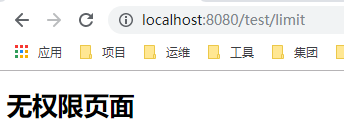1、引入依赖
<!-- 默认就内嵌了Tomcat 容器,如需要更换容器也极其简单-->
<dependency>
<groupId>org.springframework.boot</groupId>
<artifactId>spring-boot-starter-aop</artifactId>
</dependency>
<dependency>
<groupId>org.springframework.boot</groupId>
<artifactId>spring-boot-starter-web</artifactId>
</dependency>
<dependency>
<groupId>org.springframework.boot</groupId>
<artifactId>spring-boot-starter-data-redis</artifactId>
</dependency>
<dependency>
<groupId>com.google.guava</groupId>
<artifactId>guava</artifactId>
<version>21.0</version>
</dependency>
<dependency>
<groupId>org.apache.commons</groupId>
<artifactId>commons-lang3</artifactId>
</dependency>
<dependency>
<groupId>org.springframework.boot</groupId>
<artifactId>spring-boot-starter-test</artifactId>
</dependency>
2、在application配置文件中添加redis配置
spring: redis: host: ***** password:**** port: 6379 # 连接超时时间(毫秒) timeout: 1000 # Redis默认情况下有16个分片,这里配置具体使用的分片,默认是0 database: 0 # 连接池配置 lettuce: pool: # 连接池最大连接数(使用负值表示没有限制) 默认 8 max-active: 8 # 连接池最大阻塞等待时间(使用负值表示没有限制) 默认 -1 max-wait: -1 # 连接池中的最大空闲连接 默认 8 max-idle: 8 # 连接池中的最小空闲连接 默认 0 min-idle: 0
3、自定义redisTemplate
由于后续要使用lua脚本来做权限控制,所以必须自定义一个redisTemplate,此处如果不自定义redisTemplate,则执行lua脚本时会报错。
package com.example.demo.utils; import org.springframework.context.annotation.Bean; import org.springframework.context.annotation.Configuration; import org.springframework.data.redis.connection.lettuce.LettuceConnectionFactory; import org.springframework.data.redis.core.RedisTemplate; import org.springframework.data.redis.serializer.GenericJackson2JsonRedisSerializer; import org.springframework.data.redis.serializer.StringRedisSerializer; import java.io.Serializable; @Configuration public class RedisLimiterHelper { @Bean public RedisTemplate<String, Serializable> limitRedisTemplate(LettuceConnectionFactory redisConnectionFactory) { RedisTemplate<String, Serializable> template = new RedisTemplate<>(); template.setKeySerializer(new StringRedisSerializer()); template.setValueSerializer(new GenericJackson2JsonRedisSerializer()); template.setConnectionFactory(redisConnectionFactory); return template; } }
4、增加限定类型枚举类
自定义一个限定类型枚举类,后续根据类型判断,是根据ip、或是根据类型、或是根据方法名进行限流
package com.example.demo.entity; public enum LimitType { //自定义key CUSTOMER, //根据请求者IP IP; }
5、添加Limit注解
package com.example.demo.utils; import com.example.demo.entity.LimitType; import java.lang.annotation.*; import java.util.concurrent.TimeUnit; @Target({ElementType.METHOD,ElementType.TYPE}) @Retention(RetentionPolicy.RUNTIME) @Inherited @Documented public @interface Limit { //资源名称 String name() default ""; //资源key String key() default ""; //前缀 String prefix() default ""; //时间 int period();//最多访问次数 int count(); //类型 LimitType limintType() default LimitType.CUSTOMER; }
6、增加Limit注解AOP实现类
增加Limit注解的AOP切面,根据注解中的类型,使用lua脚本去redis获取访问次数
package com.example.demo.utils; import com.example.demo.entity.LimitType; import com.google.common.collect.ImmutableList; import org.apache.commons.lang3.StringUtils; import org.aspectj.lang.ProceedingJoinPoint; import org.aspectj.lang.annotation.Around; import org.aspectj.lang.annotation.Aspect; import org.aspectj.lang.reflect.MethodSignature; import org.slf4j.Logger; import org.slf4j.LoggerFactory; import org.springframework.context.annotation.Configuration; import org.springframework.data.redis.core.RedisTemplate; import org.springframework.data.redis.core.script.DefaultRedisScript; import org.springframework.data.redis.core.script.RedisScript; import org.springframework.web.context.request.RequestContextHolder; import org.springframework.web.context.request.ServletRequestAttributes; import javax.servlet.http.HttpServletRequest; import java.io.Serializable; import java.lang.reflect.Method; @Aspect @Configuration public class LimitInterceptor { private static final Logger logger = LoggerFactory.getLogger(LimitInterceptor.class); private final RedisTemplate<String, Serializable> limitRedisTemplate; public LimitInterceptor(RedisTemplate redisTemplate, RedisTemplate<String, Serializable> limitRedisTemplate) { this.limitRedisTemplate = limitRedisTemplate; } @Around("execution(public * *(..)) && @annotation(com.example.demo.utils.Limit)") public Object interceptor(ProceedingJoinPoint joinPoint){ //获取连接点的方法签名对象 MethodSignature methodSignature = (MethodSignature) joinPoint.getSignature(); //获取方法实例 Method method = methodSignature.getMethod(); //获取注解实例 Limit limitAnnotation = method.getAnnotation(Limit.class); //注解中的类型 LimitType limitType = limitAnnotation.limintType(); //获取key名称 String name = limitAnnotation.name(); String key; //获取限制时间范围 int limitPeriod = limitAnnotation.period(); //获取限制访问次数 int limitCount = limitAnnotation.count(); switch (limitType){ //如果类型是IP,则根据IP限制访问次数,key取IP地址 case IP: key = getIPAdress(); break; //如果类型是customer,则根据key限制访问次数 case CUSTOMER: key = limitAnnotation.key(); break; //否则按照方法名称限制访问次数 default: key = StringUtils.upperCase(method.getName()); } ImmutableList<String> keys = ImmutableList.of(StringUtils.join(limitAnnotation.prefix(),key)); try{ String luaScript = buildLuaScript(); RedisScript<Number> redisScript = new DefaultRedisScript<>(luaScript, Number.class); Number count = limitRedisTemplate.execute(redisScript, keys, limitCount, limitPeriod); logger.info("Access try count is {} for name={} and key = {}", count, name, key); if(count !=null && count.intValue() <= limitCount){ return joinPoint.proceed(); }else{ throw new RuntimeException("访问超限"); } }catch(Throwable e){ if(e instanceof RuntimeException){ throw new RuntimeException(e.getLocalizedMessage()); } throw new RuntimeException("服务异常"); } } /** * lua限流脚本 * @return */ public String buildLuaScript(){ StringBuilder sb = new StringBuilder(); //定义c sb.append("local c"); //获取redis中的值 sb.append("\nc = redis.call('get',KEYS[1])"); //如果调用不超过最大值 sb.append("\nif c and tonumber(c) > tonumber(ARGV[1]) then"); //直接返回 sb.append("\n return c;"); //结束 sb.append("\nend"); //访问次数加一 sb.append("\nc = redis.call('incr',KEYS[1])"); //如果是第一次调用 sb.append("\nif tonumber(c) == 1 then"); //设置对应值的过期设置 sb.append("\nredis.call('expire',KEYS[1],ARGV[2])"); //结束 sb.append("\nend"); //返回 sb.append("\nreturn c;"); return sb.toString(); } private static final String UNKONW = "unknown"; /** * 获取访问IP * @return */ public String getIPAdress(){ HttpServletRequest request = ((ServletRequestAttributes) RequestContextHolder.getRequestAttributes()).getRequest(); String ip = request.getHeader("x-forword-for"); if(ip == null || ip.length() ==0 || UNKONW.equalsIgnoreCase(ip)){ ip = request.getHeader("Proxy-Clent-IP"); } if(ip == null || ip.length() ==0 || UNKONW.equalsIgnoreCase(ip)){ ip = request.getHeader("WL-Clent-IP"); } if(ip == null || ip.length() ==0 || UNKONW.equalsIgnoreCase(ip)){ ip = request.getRemoteAddr(); } return ip; } }
扫描二维码关注公众号,回复:
7711229 查看本文章


6、增加访问控制类
在控制层添加Limit注解,返回访问次数。
@ResponseBody @GetMapping(value = "limit") @Limit(key = "test",period = 100, count = 5) public String testLimit(){ return "第"+ATOMIC_INTEGER.incrementAndGet()+"次访问"; }
7、测试

当访问超过次数后,抛出异常信息(此处无权限是由于添加了shiro集成的原因)
